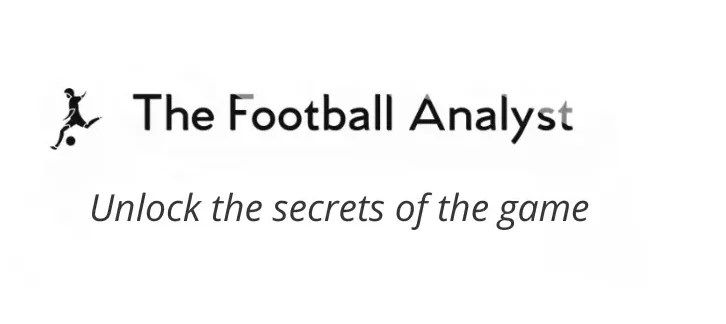In this article, we dive into the tactical world of Germany under the management of Julian Nagelsmann. Known for his innovative and forward-thinking approach, Nagelsmann has brought a fresh perspective to the German national team. We will explore his tactical principles, formations, and key strategies that define his coaching style. From the build-up play to the defensive organization, this analysis will provide a comprehensive look at how Nagelsmann aims to reshape and elevate Germany’s performance on the international stage. Join us as we uncover the tactical nuances that make Julian Nagelsmann one of the most exciting managers in modern football.
Build-up
Low Build-up
In the low build-up, Nagelsmann sets his team up in a 1-4-2-3-1 formation, with a back four, two holding midfielders, a number-ten, two wingers, and a striker.
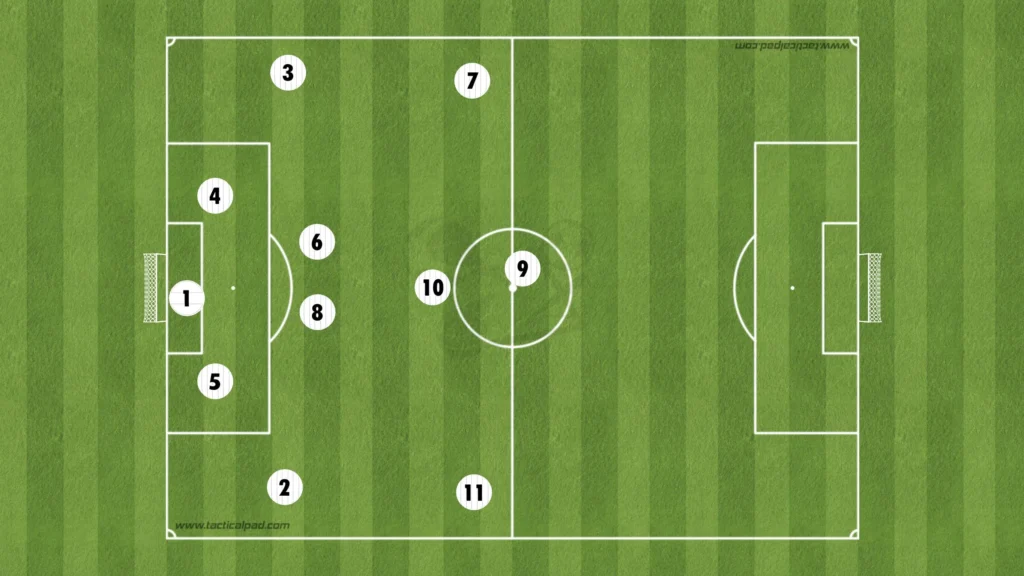
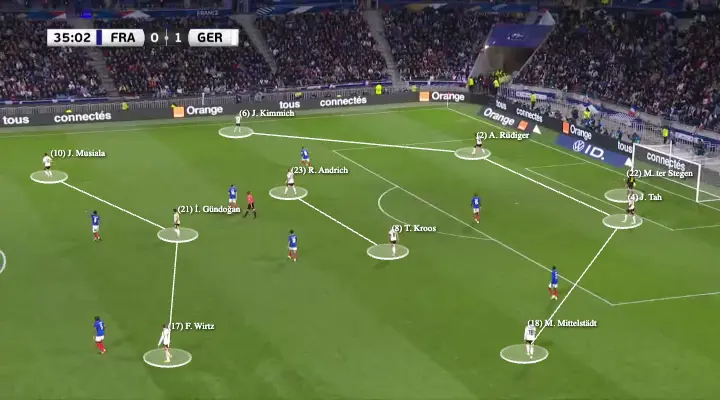
The striker, Kai Havertz, often drops during the low build-up, creating a 1-4-2-2-2 formation with two number-tens and two wingers high and wide.
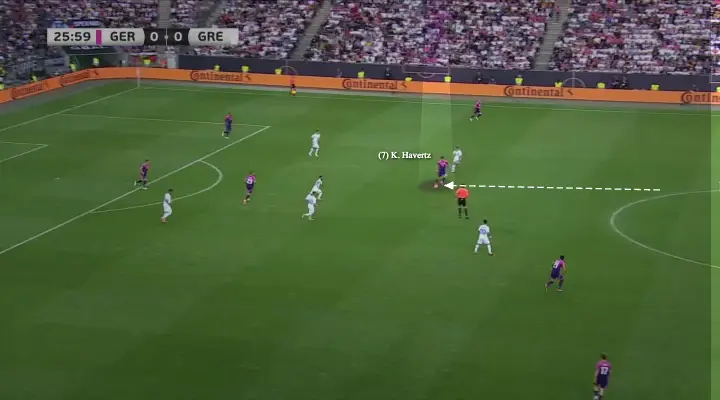
This formation, popularized by Roberto De Zerbi, questions the opposition center-backs, forcing them to make difficult decisions. If they push up on the number-tens, the space behind them opens up, giving the winger a 1v1 against the fullback. However, If they do not push up, a numerical superiority gets created in the midfield, allowing Germany to play through the press.
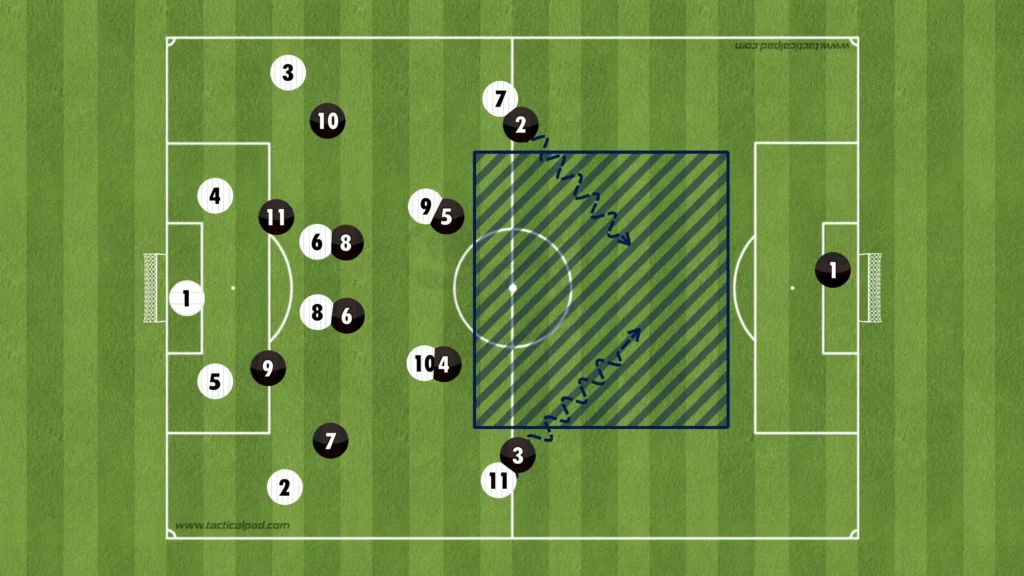

High Build-up
In the high build-up, Nagelsmann changes the formation to a 1-3-1-5-1 formation.
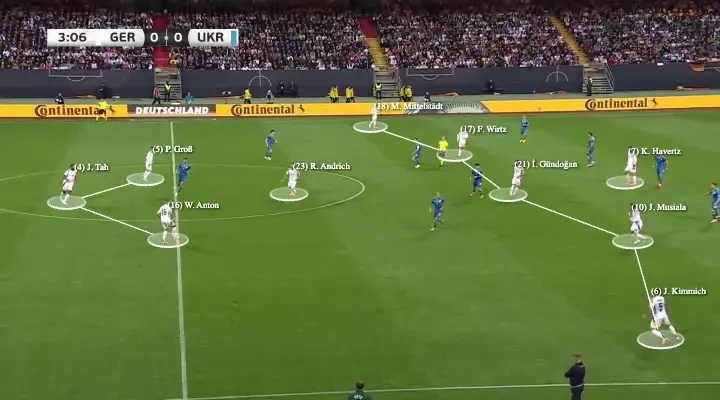
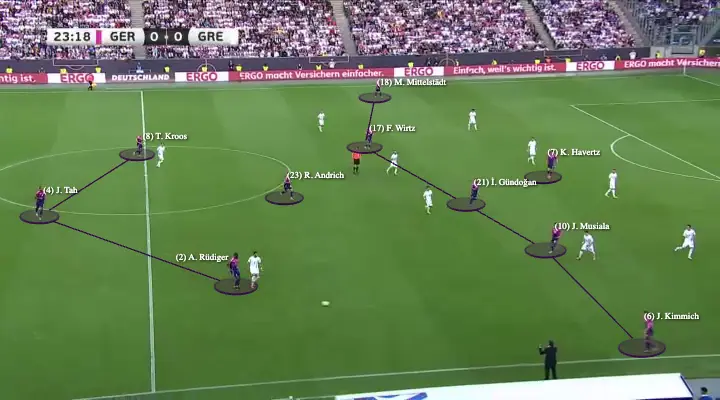
They usually rotate into this formation by pushing the fullbacks, Kimmich and Mittelstädt, up into a winger position, the wingers, Wirtz and Musiala, into an attacking midfield position, and one of the holding midfielders, usually Toni Kroos, into the backline.
Having four central midfielders(one holding and three attacking) creates more options in the center and less space between the players. Nagelsmann likes this because he prioritizes playing through the middle. He needs one player high and wide to pull apart the backline while the rest create numerical advantages in the midfield areas. This builds good conditions in defensive transitions, allowing more players to press when they lose the ball. Another purpose for keeping many players in the middle is to shorten the distance between them. This shortens the length of the passes, which naturally shortens the time between passes. This means the opposition players will have less time to push up and press, giving the German players more time and control.
Toni Kroos’ role in Nagelsmann’s system
Toni Kroos is often the holding midfielder who drops into the backline during the build-up phase. This gives him more time on the ball, which enables him to find long passes out to the wingers or in behind the opposition’s backline. Germany’s attacks usually start through Kroos, and every time the opponents commit to one side, Kroos will find the long switch over to the other side.
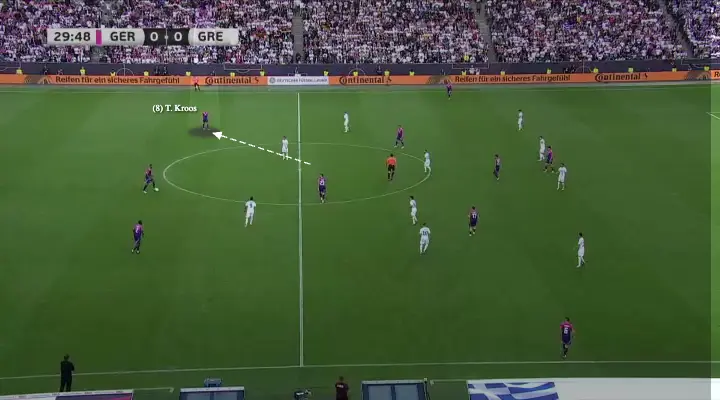
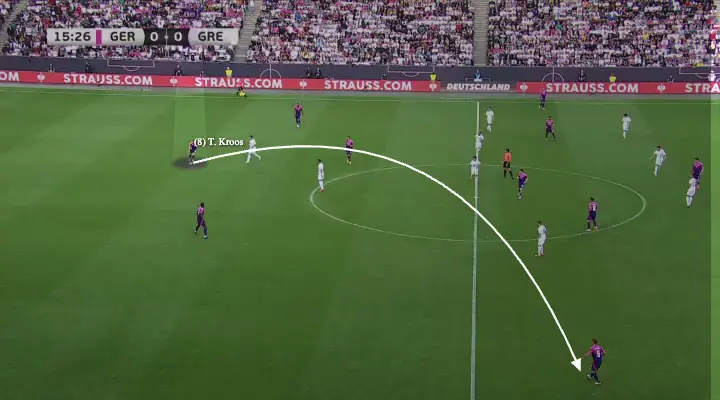
The opposition players often react to this by pushing up and being very aggressive on Kroos when he drops. This can, however, open big spaces in the midfield for the other German midfielders to exploit.
High Backline
A massive aspect of Nagelsmann’s high possession build-up is they keep a high backline. This helps in the counterpress because they get closer to the center. Having more players close to the center who can win the ball back makes it difficult for the opposition to do anything when they win possession. Furthermore, the high backline shortens the distance between players, shortening the time and length of the passes and preventing the opposition from pushing up their defense.
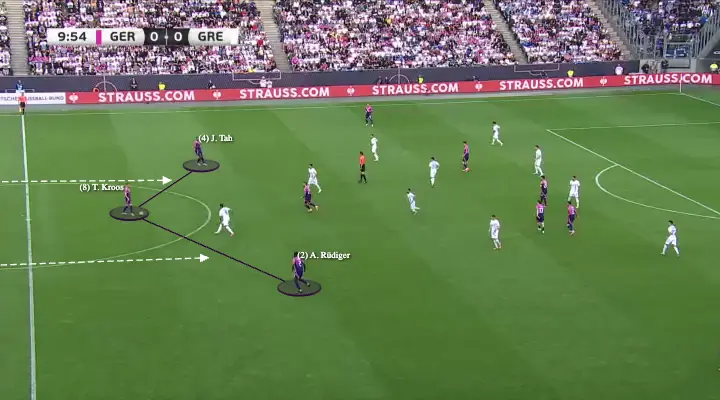
+1 in the Backline
Nagelsmann usually wants his team to be +1 in the backline against the opposition’s forward line. If they are +1, one center-back will be free. The ball can be played to the free center-back, who can take the ball forward, beating the opposition’s first line. When playing against two forwards Nagelsmann also wants the number-six to play between the opposition strikers. This forces them to come in more, which opens more space for the wide center-backs to take the ball forward.
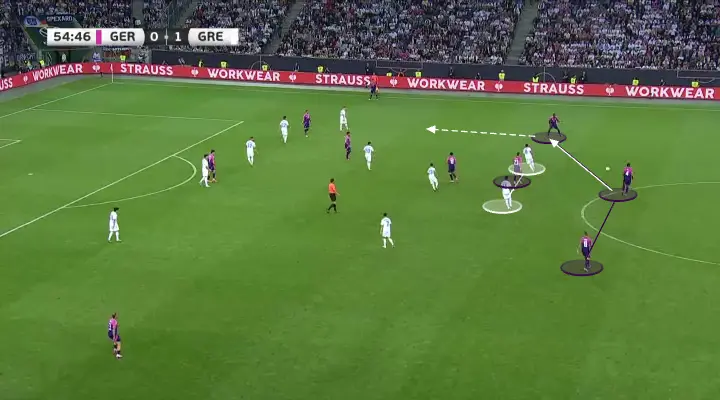
Nagelsmann does not, however, want to be +2 in the backline against the opposition’s forward line. He wants a numerical advantage, but with two players more than the opposition, they could have more players higher up the pitch. Therefore, Nagelsmann will push the dropping holding midfielder back into the midfield, creating a 1-2-2-5-1 formation when playing against one forward. He does this because they get an extra midfielder without losing the numerical advantage at the back. With a 2v1 with the backline against the opposition’s forward line, one center-back will still be free, which allows them to beat the opposition’s forward line and progress the ball up the pitch.
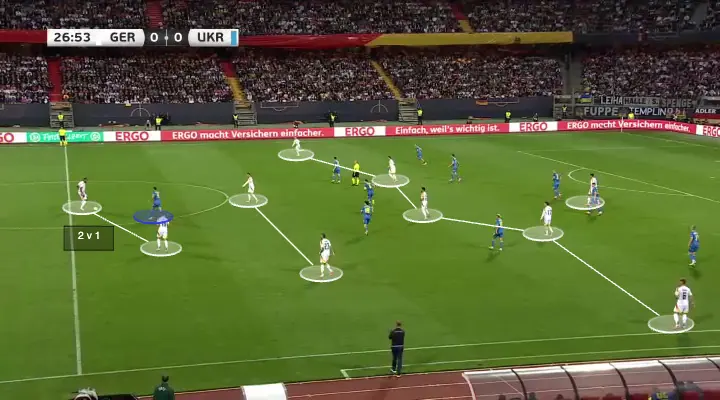
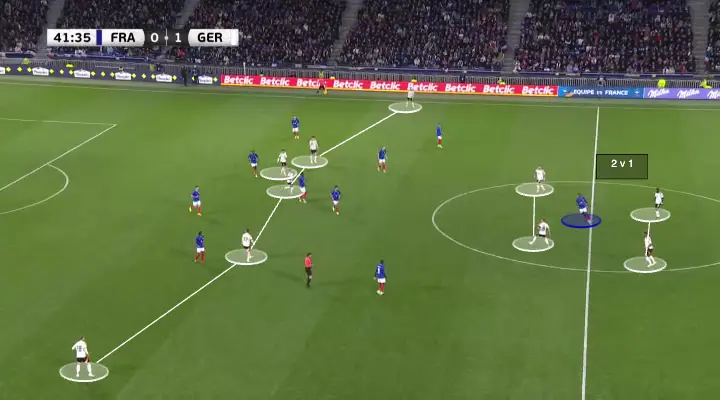
Kimmich Dropping
Joshua Kimmich sometimes drops from his right-wing position to a right-back position during the high build-up. This gives Germany more options lower down the pitch, which helps them beat the opposition’s first line of pressure. It also attracts the opposition fullback, which opens the space behind him.
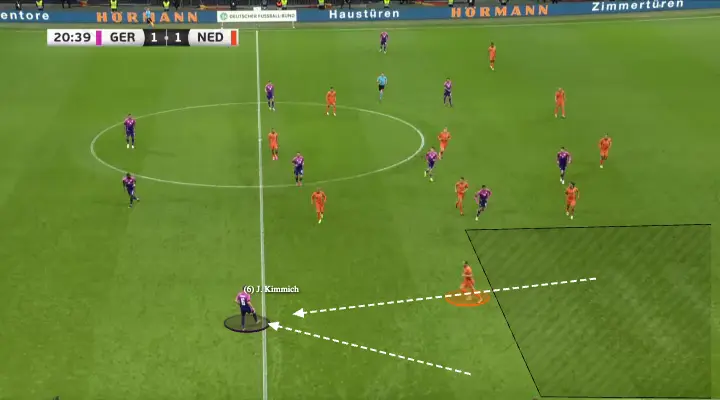
Germany will exploit this space with the attacking midfielder, who will run into the open space and receive a pass from Kimmich. From there, the attacking midfielder can cross the ball into the box or attack the opposition center-back in a 1v1 situation.
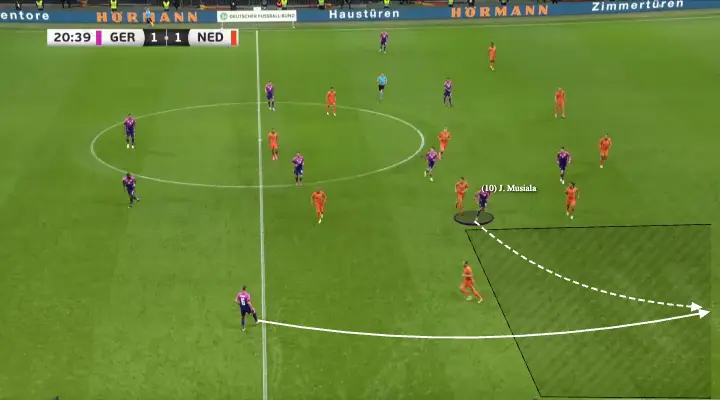
Numerical Advantages
Another massive aspect of Germany’s high build-up is their ability to create numerical advantages against the opposition’s defensive line. Their front six players naturally become numerically superior against the opposition backline, which they are great at taking advantage of.
For example, when the defending team is positioned on one side, the weak-side fullback becomes vulnerable to the long switch of play due to the 1v2 against Germany’s winger and attacking midfielder. Nagelsmann’s team often capitalizes on this by getting the ball to the winger and creating many opportunities from 2v1 situations on the wing and in the half-spaces.
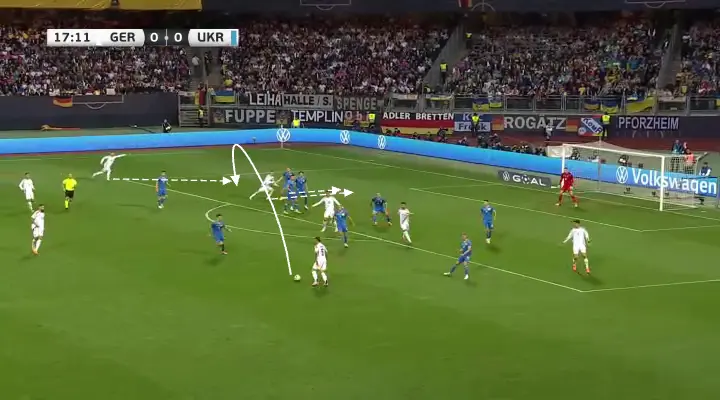
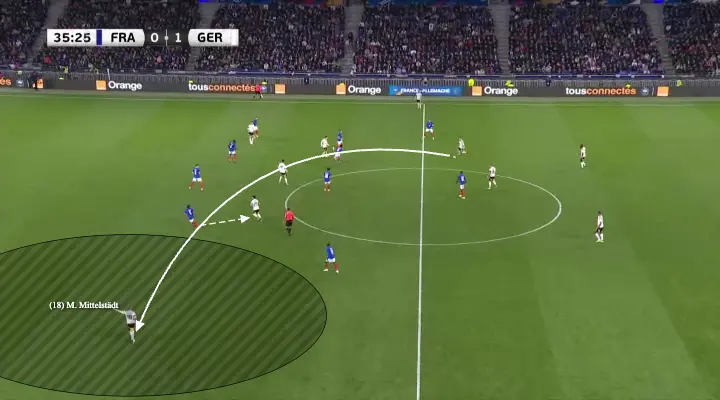
Final Third
Attacking the Half-Space
Nagelsmann’s teams usually look to create chances by attacking the space between the opposition center-back and fullback. They primarily do this from the wide areas with underlaps from the attacking midfielders. When the winger receives the ball he will attract the opposition fullback. This opens the space between the fullback and the center-back, which allows the German attacking midfielder to make the underlapping run into this space. The ball can be played to the attacking midfielder, who can cross the ball into the box or attack his defender in a 1v1 situation.
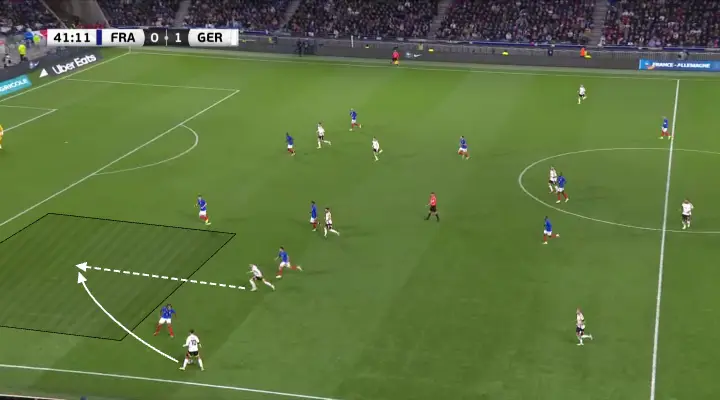
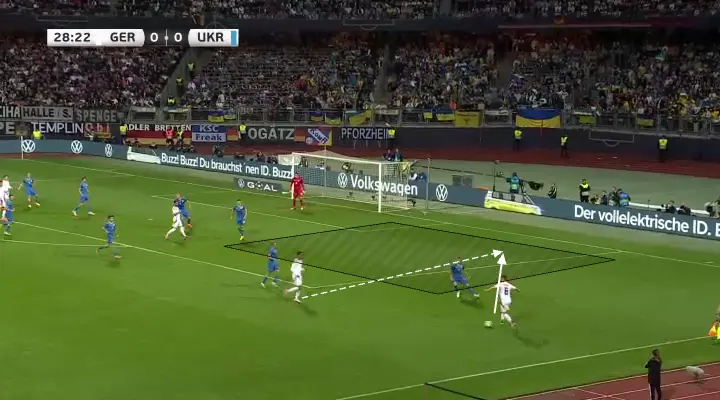
The winger does not have to play the ball to the underlapping player. The underlapping player will often drag away a defensive midfielder, which opens the space inside. The winger can take the ball inside and shoot or find a pass to a free player in front of the backline. Here, the space in front of the backline opens up because the defensive midfielder leaves his position to track the underlapping run. The ball is played to the free number-ten, who can take the ball forward and attack the defense.
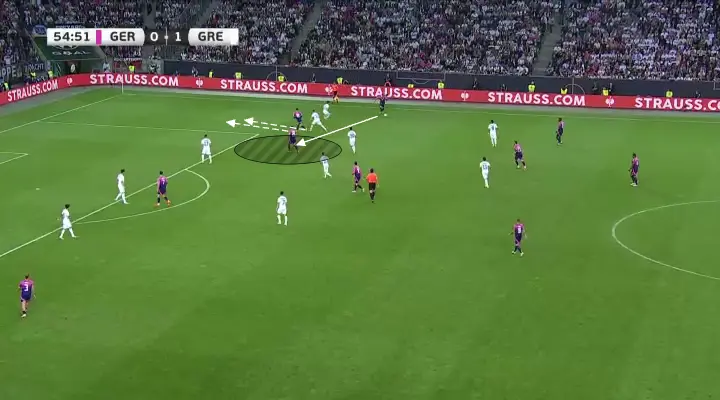
Nagelsmann’s team also exploits the space between the center-back and the fullback by playing through-balls from the midfield or backline into a run from an attacking midfielder.
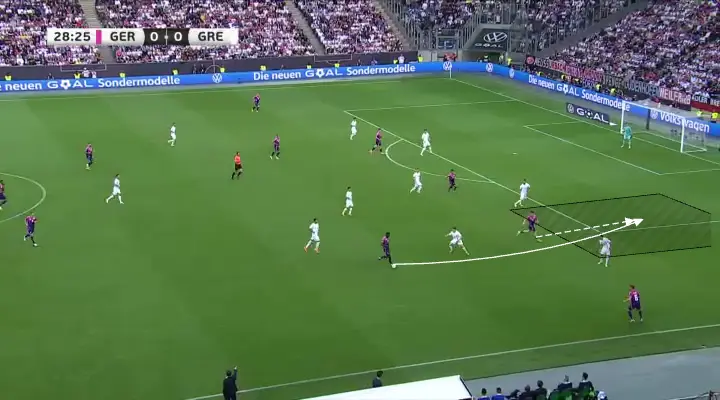
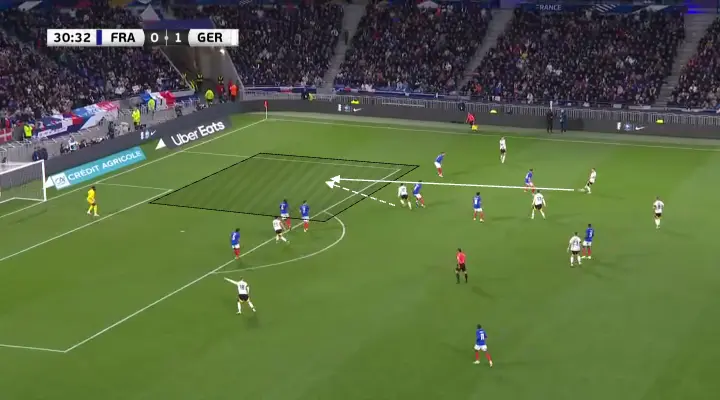
Many Players in the Box
The attacking midfielders and wingers look to make runs into the box when the ball is in the final third, often getting four or five players into these areas to create overloads. The numerical advantages in the box force the defending team to make decisions and leave some players open.
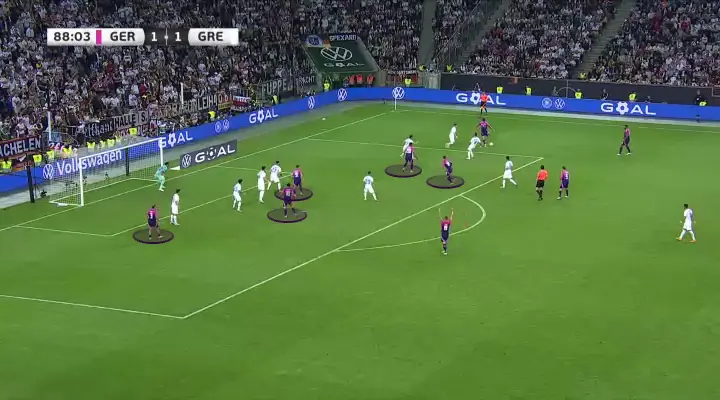
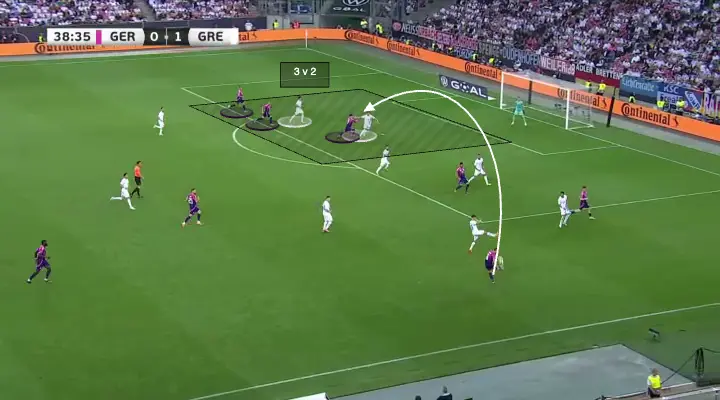
Nagelsmann also positions many players outside the box, ready for the second balls and cut-backs. They always succeed in pushing down the opposition’s defense, which opens the space in front of the backline. The midfielders will often be found in these spaces with cut-backs, and from there, they can shoot or combine with an attacker to create goalscoring opportunities.
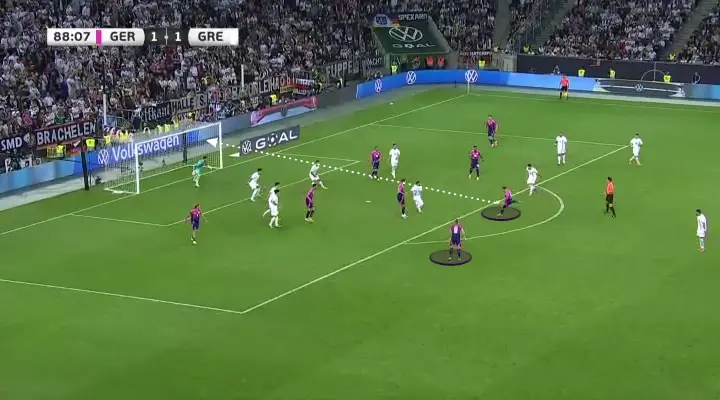
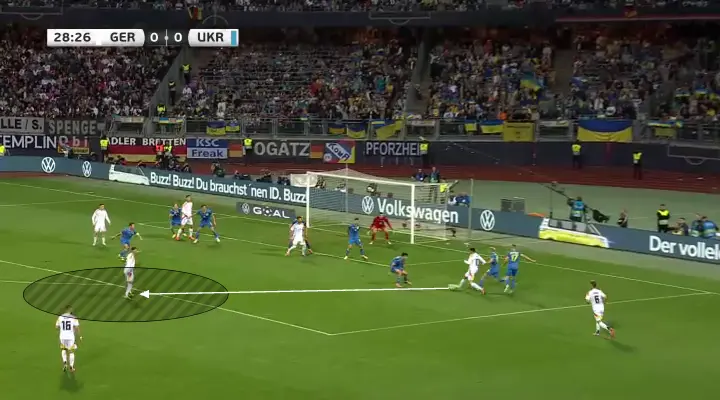
Defending
High Press
Naglesmann places much value on being aggressive without the ball. This shows in Germany’s high pressure. Nagelsmann usually wants his team to go man-to-man and intensely press the opposition. They almost use their high press as an attacking threat, scoring many goals from winning the ball high up the pitch.
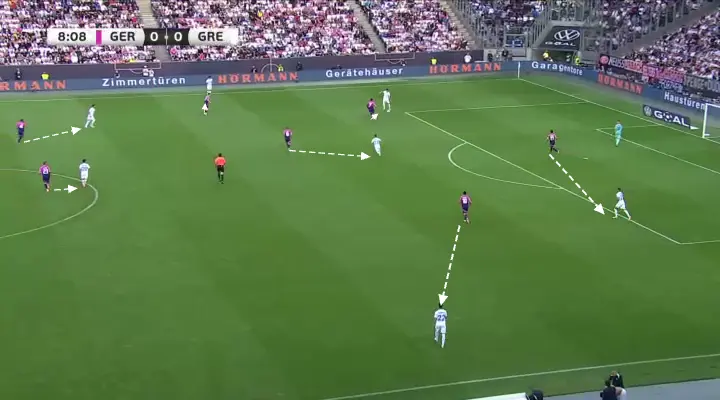
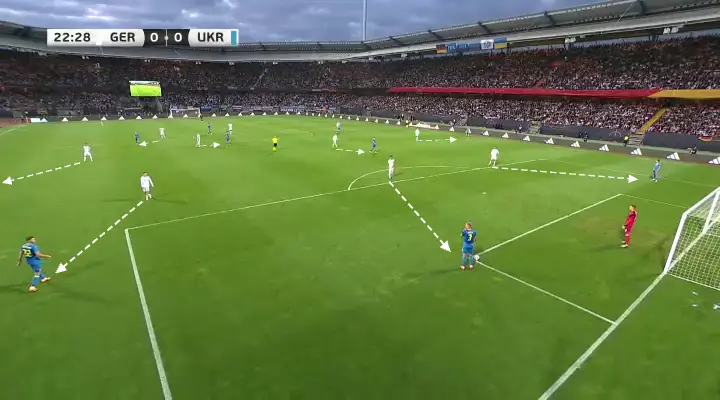
Low Press
In the low press, Nagelsmann’s Germany uses a 1-4-2-3-1 formation. They look to set up in a mid-block, always trying to close the center, forcing the opposition out wide.
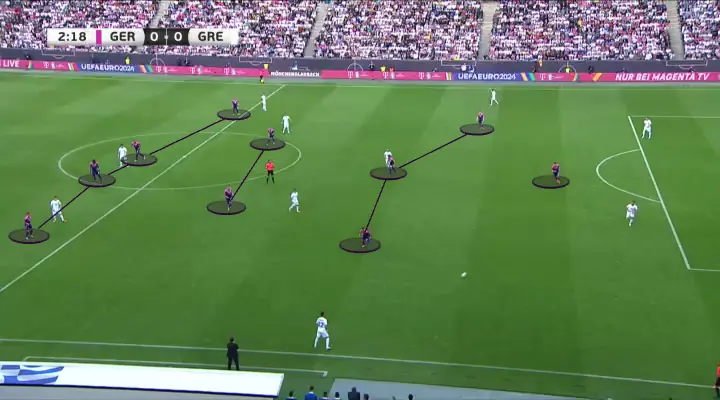
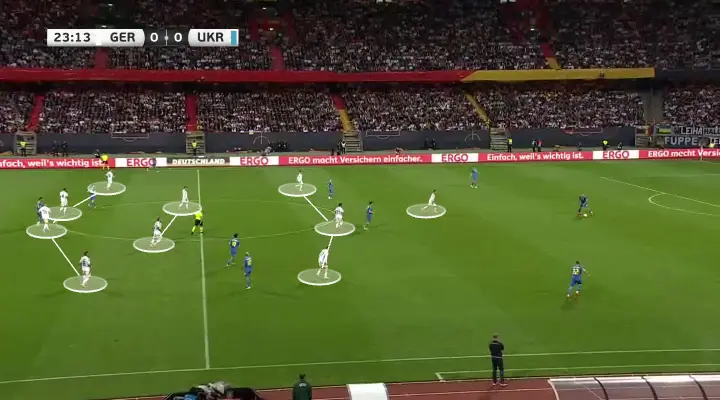
Nagelsmann always wants his team to squeeze the pitch when defending. This means constantly pushing the team up as much as possible when defending. Every time the opponent plays a slow, sideways pass or a back pass, Germany’s first line of pressure pushes up, with the rest of the team following to stay compact. When the next pass comes, they push up even more, forcing the opponent back even more. They do this because it pushes the opponent further away from the German goal, making it harder to create chances.
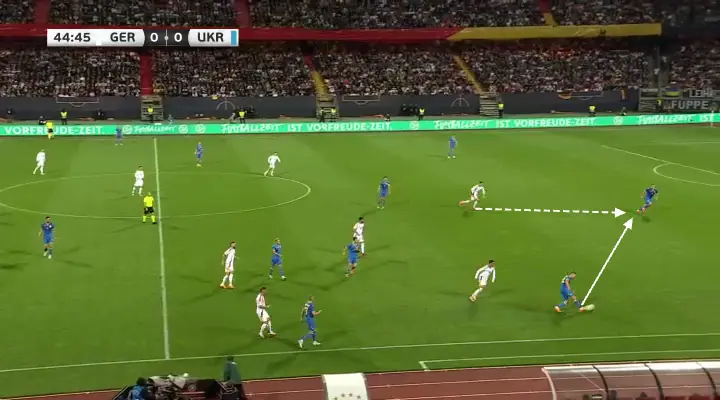
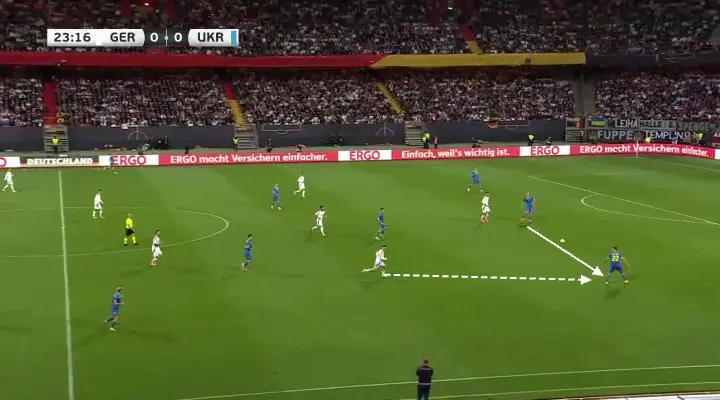
Defensive Transitions
Positioning many players centrally, creating a numerical advantage in the midfield, creates good conditions in defensive transitions. Many players close to the ball after losing possession means that many players can work towards regaining possession. Nagelsmann’s players are also very aggressive in the first seconds after losing the ball. The four or five players closest will immediately jump on the opposition player with the ball and close the distance to cut off any passing lanes. Nagelsmann’s team, therefore, often regains possession directly after losing it. When they regain possession, they try to recycle the ball, not wanting to lose possession again.
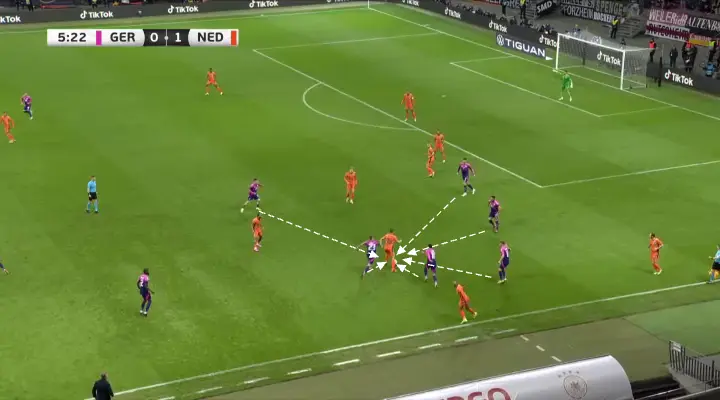
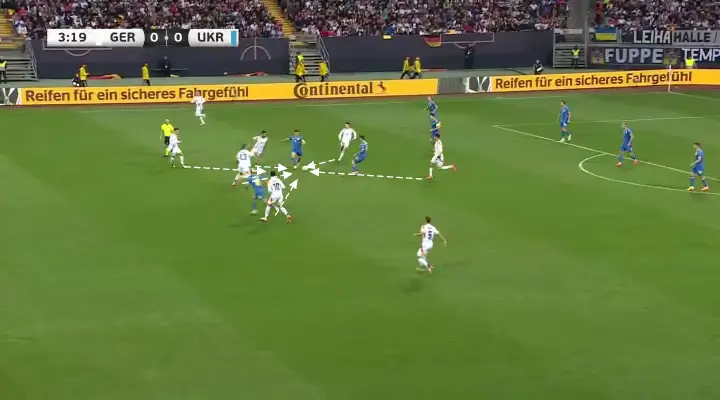
Another thing that Nagelsmann does to better Germany’s counterpressing conditions is to push the weak-side winger in towards the middle. When the ball is on one side, the winger on the other side, Kimmich or Mittelstädt, will come into the middle. This gets them closer to the ball, allowing them to contribute more to the counter-press when Germany lose the ball. If the ball gets played to a German player with more time, the winger will come back out and be ready for the long switch.
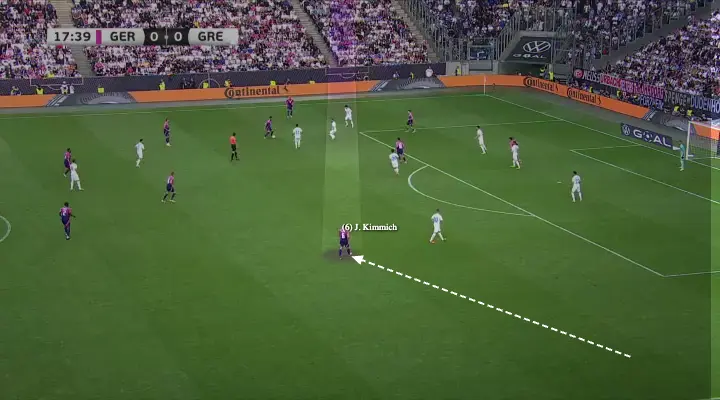
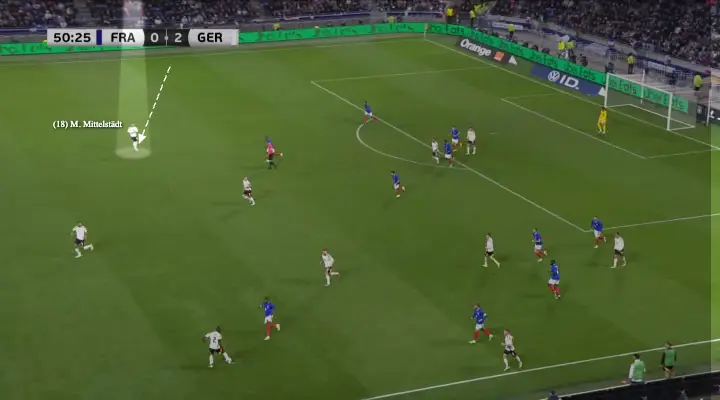
Final Thoughts
In conclusion, Julian Nagelsmann’s tactical approach with the German national team showcases his innovative and adaptive coaching style. By implementing versatile formations, emphasizing high-intensity pressing, and fostering fluid attacking movements, Nagelsmann has brought fresh and dynamic energy to the team. His ability to blend young talent with experienced players has created a cohesive unit capable of executing complex strategies on the field.
This tactical analysis highlights Nagelsmann’s commitment to modern football principles and his keen understanding of the game’s intricacies. As Germany continues to evolve under his leadership, fans can expect a team that not only competes at the highest level but also plays an exciting and intelligent brand of football. The future looks promising for German football, with Nagelsmann at the helm, steering the team towards success with his tactical understanding and innovative approach.
